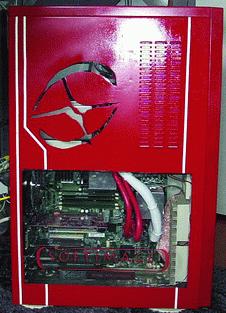

I had a dual-processor system built by Los Alamos Computers in February 2002. The system would lock up shortly after being powered on. I pulled the cover off and saw that one of the CPU fans was not spinning. LAC promptly sent out two new CPU fans with instructions for installing them. I installed the new fans, but the system was no more stable. Gary at LAC suggested that maybe a processor had been damaged from overheating, and they asked me to return the whole system. I received the system back shortly thereafter and had been happy ever since—until around August 19, that is. The system started locking up again. Larry started to suspect the Tyan 2460 motherboard and recommended returning the system to him so he could replace the board with an ASUS A7M266D. They also put in a quieter case and CPU fans, with my approval, again at no charge. I now have the system back, with a new motherboard and all new case and CPU fans. It is so quiet now, I can run it in the dining room and my wife does not mind. LAC truly stood behind their product.
—Chris Hajer
This series (beginning with “Introducing AOLserver”, September 2002) will make my LJ subscription worthwhile. Reuven, you can quote that.
—Lamar Owen
Thought you might enjoy this picture taken on the Great Wall in China. Fitting, I thought, for the “In a World without Fences...” message on the Linux Journal T-shirt. I was in Asia for a series of Linux meetings across Beijing, Seoul, Hong Kong and Tokyo (I work for a large, three-letter acronym company that is heavily focused on Linux). During this trip, my LJ shirt was very popular at all locations—washed periodically, of course.
—Bill

Red: the New Beige?
I just finished reading your article on the Ultimate Linux Box [LJ, September 2002] and am happy to say that I have the exact components you mentioned. I have not installed Linux as of yet, but as proof of the SC760 case being paintable and modifiable take a look at what I did to my case.
—Will Mendez
I'm writing in response to Mr. Scarbrough's letter on page 6 of the October 2002 issue: “Turn That Thing Down!”. I too was terribly annoyed with the constant wind-tunnel sound coming from my always-on PC and found the following solution. My first step was to install LMsensors so I could read the temperature sensors on the motherboard, an ABit VP6. Without any changes, the CPU temps were about 95-98°. I then underclocked the CPUs down to 466MHz and reduced the CPU core voltage to only 1.30 volts. This reduced the CPU temp to almost room temperature.
Then, I disconnected both CPU fans and watched the temp climb up to 109-111°. I then rewired the three-wire CPU fans to run at 5 volts with the third wire disconnected. At this speed, the CPU fans were dead silent and CPU temp dropped back to room temp.
Next, I replaced my NVIDIA GeForce2 card and its noisy fan with an older Diamond Viper V550 video card without any fan at all. I'm a housewife, not a gamer, so I'm not missing anything here.
Next, I rewired the power supply fan to use only 5 volts instead of 12. This made the power supply fan dead quiet. To be on the safe side, I added another fan wired to the 5 volt supply on the bottom of the case to draw cool air into the case. Good 12 volt fans running at 5 volts make practically no sound.
Running with the above mods, my computer is near dead silent, and I can't hear anything unless I put my ear just a few inches from the case. The CPU temp is a nice cool mid-80s even when compiling or playing music. I run Apache with PHP, MySQL, cidd, SSH, e-mail, Galeon and dozens of other off-the-net and custom programs. I really don't notice any difference between running at 933MHz and 466MHz, and even in the dead of night, the only indication the computer is running is the little light on the front.
On a side note, I discovered with LMsensors, I can read the status of the “chassis intrusion switch”. I'm not sure how I'll use this yet, but you can be sure I'll come up with a more interesting use for this than detecting “chassis intrusion”.
—Mrs. Kim Genrich
Thanks for the tips. (Readers, remember that only people trained in high-voltage safety should open or modify power supplies.)
—Editor